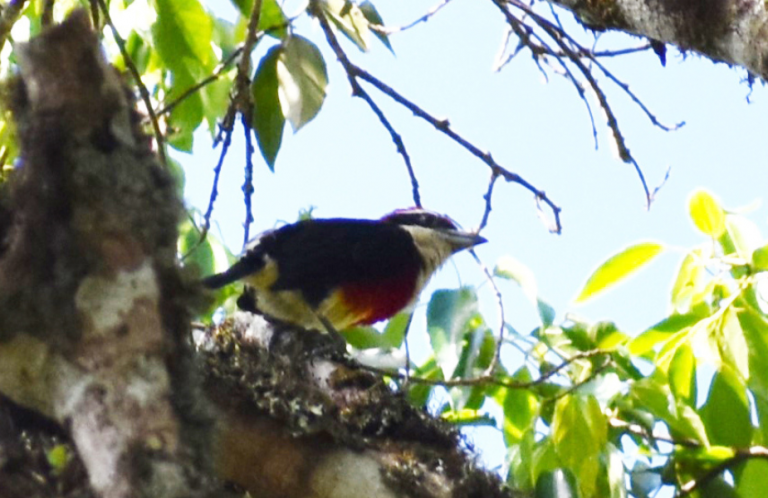A Champion for Flammulated Owls and Other Birds of the Pacific Northwest
Conservationist Bob Altman spent more than half of his 20 years at ABC working in ponderosa pine forests of Pacific Northwest to restore habitat for cavity-nesting birds such as the Flammulated Owl and Lewis's Woodpecker. By the time Altman retired in late 2017, ABC had collaborated with partner organizations and private landowners to conserve more than 32,000 acres of ponderosa pine habitat in Oregon.
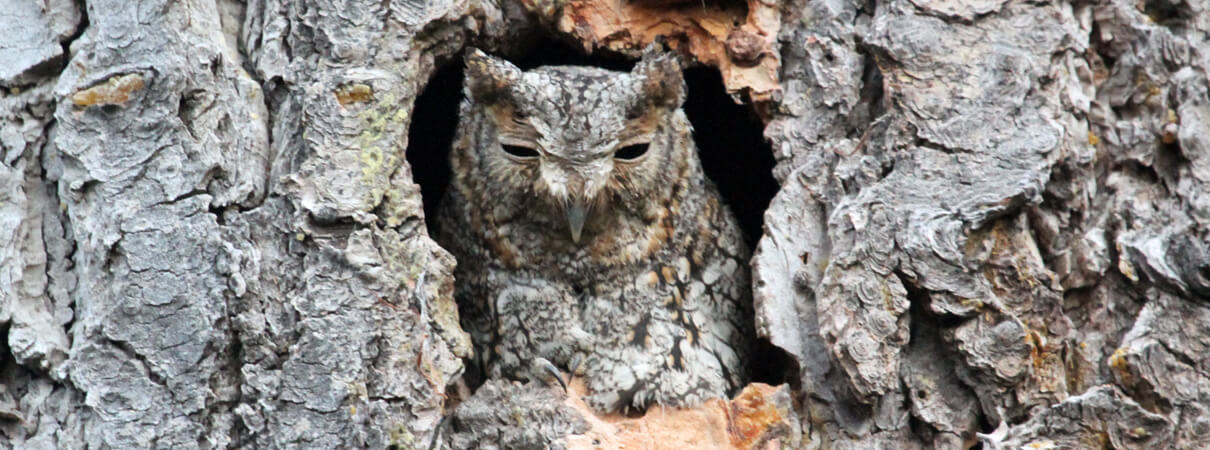
Flammulated Owl by Rob Lowry
We recently caught up with Altman to learn more about ponderosa pine systems, the important role of private landowners in bird conservation, and some other imperiled regions of the Pacific Northwest where declining bird species are facing serious threats.
Q. Where do we find ponderosa pine forests, and what makes them so important for birds?
A. Ponderosa pine forests occur in the western half of North America, all the way up into Canada and down into Mexico. They evolved with natural fires, which were sometimes set by lightning, sometimes by Native Americans. These low-intensity fires would just burn in the understory — the needles, small brush — and left a fairly open landscape, almost parklike.
Fire suppression came along after settlement of the West. These ponderosa pine systems changed. What typically was a parklike situation became invaded with smaller, younger trees and brush. The forests didn't get the sort of cleansing that fire brings. They became mixed and dense forest. Of course, when the forest type changes, that's going to affect the flora and fauna that exists there. It created different habitat conditions.
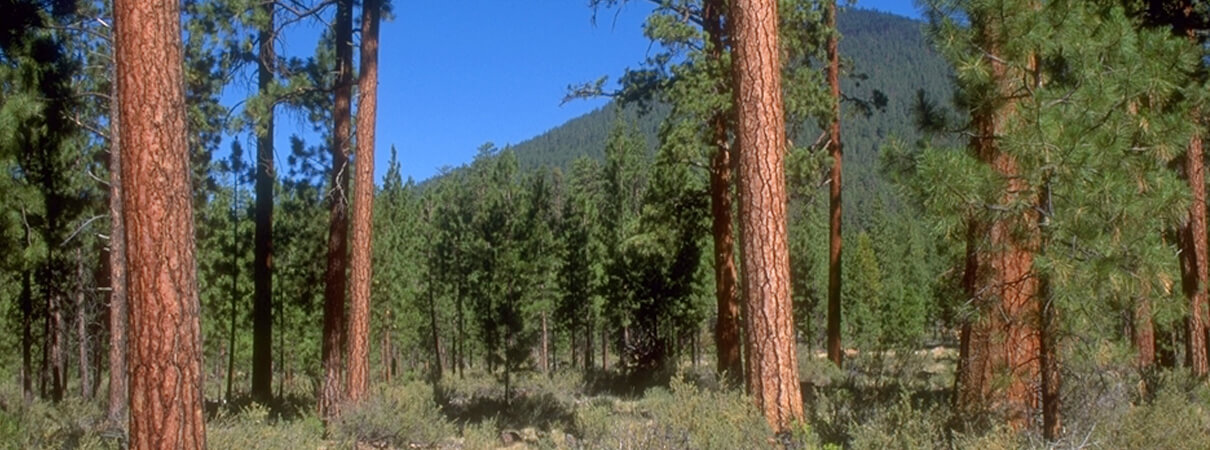
Ponderosa pine habitat by Dan Casey
Q. What bird species is ABC most concerned about?
A. Lewis's Woodpecker, Flammulated Owl, White-headed Woodpecker, and Williamson's Sapsucker. They're all cavity-nesters, all declining, and all recognized as priorities on national and regional watch lists.
Q. Why are ponderosa pine forests so important for these cavity-nesting birds?
A. With the exception of Flammulated Owl, these are pretty good sized woodpeckers. So they need bigger trees. And the older trees are more likely to have the conditions for excavating cavities. Older trees have some degree of internal rot or defects. The birds are going to focus on the parts of the tree where those conditions are. A nice big, hard tree that's young and vigorous is much more difficult to excavate a cavity in.
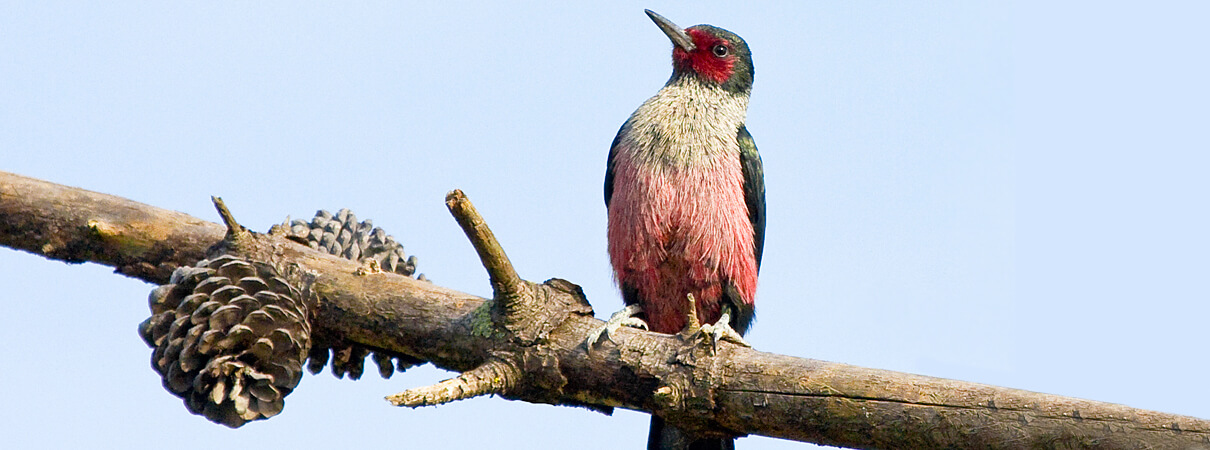
Lewis's Woodpecker by Teddy Llovet
Q. How have the changes in the landscape affected these birds?
A. All four of the species ABC focuses on are of concern because of their population declines. Yet at the same time, they're all a little different in what they want from ponderosa pine forest.
For example, Lewis's Woodpeckers require a very open forest, almost savanna-like, with scattered trees. Flammulated Owls like a little more closed forest. They're really small, and when you're small, you're prey for a lot of things. So they like some closed areas, some dense thickets where they can escape.
White-headed Woodpeckers like a fair degree of forest that have partially burned. Williamson's Sapsucker looks for a weak spot in a tree where it's going to be easier to excavate.
They all utilize different conditions or different niches within that forest. All need cavities — but then they differ in terms of the conditions they want around those cavities.
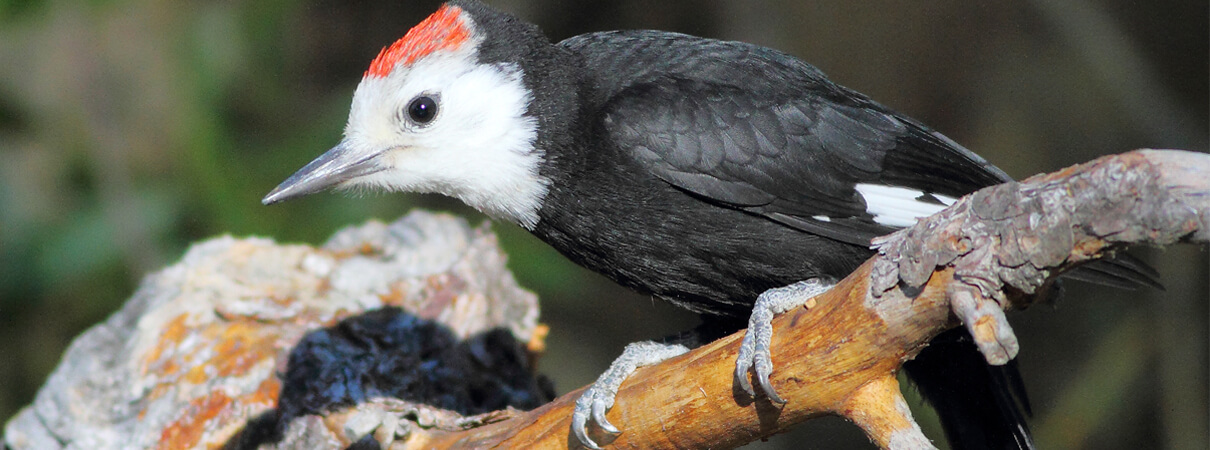
White-headed Woodpecker by Greg Homel/Natural Elements Productions
Q. That sounds challenging from a conservation perspective. How do you manage the forest to accommodate the needs of all these species?
A. That's exactly right. You really have to think of landscapes if you're going to be managing for a suite of species. If you want to address the needs of all these species, you have to build a mosaic of conditions.
It's the art of science. We use science to set our standards. We determine what these birds need based on studying them. Once we have that information, and we're trying to manage a landscape for multiple species, that's where the art comes in. You have to be able to prescribe a variety of conditions across the landscape.
Q. Are ponderosa pine forests mainly on public lands, or private lands?
A. It's about 40 to 45 percent private and the rest is public. Of the ponderosa pine forests that occur on public lands, most are on U.S. Forest Service land.
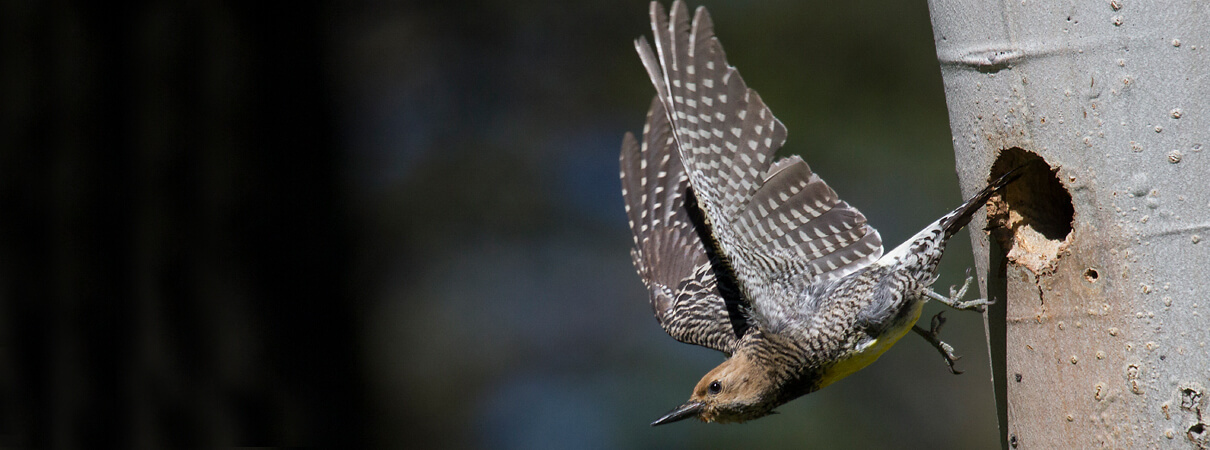
Williamson's Sapsucker female leaving nest hole by Ron Dudley
Q. Does this composition make it easier or harder to do the type of conservation work you're describing?
A. It depends on where you are. If the area is dominated by public lands, then you have a large landscape to work in with just one ownership. But when private lands are intermixed — out West it's called checkerboarding, where private lands are interspersed with public lands — that's obviously more challenging. The Forest Service is doing something on their land that private landowners might not be doing on their land, and they're right next door to each other.
This is where ABC comes in. We felt that the gap was private lands.
Q. So what role do private landowners play in restoring these forests?
A. It's highly variable. Our role is to find out where there's overlap between what landowners want and what we want. Obviously we know going in that we would like to create more snags or more situations for cavity development. We would like to, where applicable, thin out the forest to get it back to more historic conditions, and create some of these unique features for these birds.
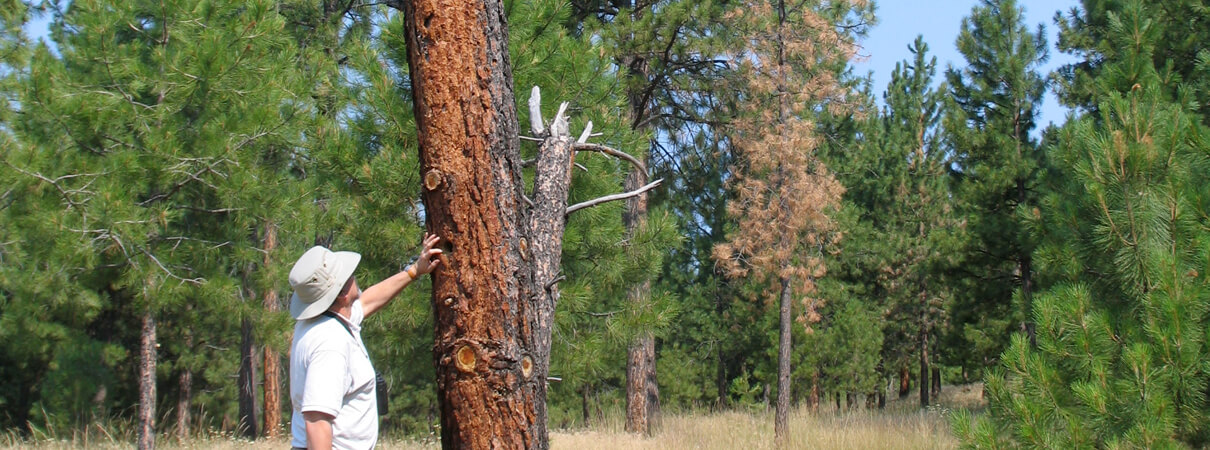
A conservationist inspects a ponderosa pine snag. Photo by Darin Stringer
But to be honest, when we go out there, our first objective is to find out what the landowner's interest is and what they want — because that's going to drive it. It's all about building trust with the landowner. They're interested in doing good things for wildlife and birds; they wouldn't be on our list otherwise. But there's got to be trust.
Q. All the work you've done in ponderosa pine forests has recently led to the creation of a new program called Flammulated Friends. Say a little more about it.
A. We decided to zero in on one particular species, Flammulated Owl, and start looking at the full life-cycle. Flammulated Owls are one of the few owls that are migratory. They breed throughout the West and tend to winter in Mexico. Our first project is working with a private landowner to acquire a conservation easement that would protect about 1,200 acres from development, and also include a certain amount of habitat restoration.
In phase two, we are proposing to link up land trusts in the western U.S. with sister land trusts or sister conservation groups in Mexico, where these birds winter. We're going to put geolocators on Flammulated Owls to see where they go. Then, once we determine where they're wintering, we'll try to facilitate relationships between the conservation groups down there with the land trusts up here. So there's the potential for full life-cycle conservation.

Flammulated Owl by Brandon K Percival/Shutterstock
Q. You've also done a lot of work in oaks and prairies. Which species do you focus on, and why?
A. I tend to focus on the most imperiled species, and also the ones that are on the national Watch List. The two species I've focused on the most are both subspecies — Streaked Horned Lark, which is federally threatened, and the Oregon Vesper Sparrow, which ABC has petitioned for listing under the Endangered Species Act. Their populations number less than 2,000 and 3,000 individuals, respectively.
The prairie-oak system is of high concern. The challenges are mostly from changes that result from the human footprint, including development and agricultural conversion that results in unsuitable habitat. These are the interior valleys between the Cascade Mountain range and the coastal range — it's where everybody lives. It's Seattle, Portland — that's where the prairie-oak system used to be.
These birds are facing extirpation from the area. Their numbers have gotten so low. In a landscape that continues to be developed, we're trying to take those species right on the edge and strategize on what we need to do to save them?

Oregon Vesper Sparrow by Klamath Bird Observatory
Q. So how do you even do that?
A. As a conservationist, you start with your rule number one, which is to protect what you've got. You identify the places where the birds still are, and determine if there's anything we need to do to maintain those places. Then you do what you can to improve their potential in other places.
The majority of the land in this part of the world is private. So it goes back to a lot of working with private landowners or land trusts. It's a familiar story in dealing with a lot of endangered species — you're working from the bottom up.
Q. How did your work evolve in the 20 years you were with ABC?
A. The main change that I have observed working in this field is the emergence of the importance of private lands in bird conservation. When I started, even before ABC, conservation in general and even more specifically bird conservation was about public lands. But there's been more of a realization of the potential for engaging private landowners in bird conservation. We've realized we just can't rely on public lands to answer all of our concerns about conservation.
Q. What makes you hopeful for bird conservation?
A. The accumulation of small victories. Here's a good example. I led an effort to reintroduce Western Bluebirds on the San Juan Islands. They had been extirpated from there for 30 to 40 years. So we started a reintroduction program in early- to mid-2000s. Now there must be 20 to 30 pairs 10 years later. You might say, “That's not very many,” but it took a lot to get birds to stay there, successfully nest there, and come back.

Western Bluebird by Birdiegal/Shutterstock
Q. Of all the bird species you've worked on, do you have a favorite?
A. [Laughs] You know the answer to that one! It's the one in front of me right now. And that moment changes all the time.
 | Bob Altman retired in late 2017 after 20 years at ABC, most recently serving as Pacific Northwest Conservation Officer. |
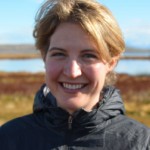 | Libby Sander is ABC's Senior Writer and Editor. |








































